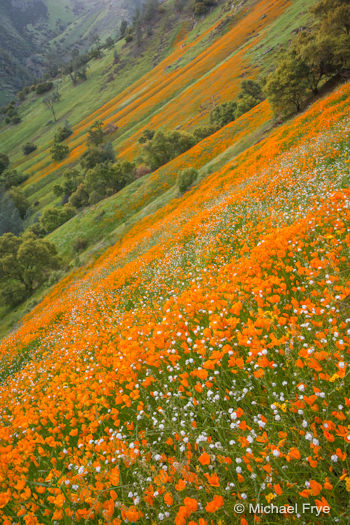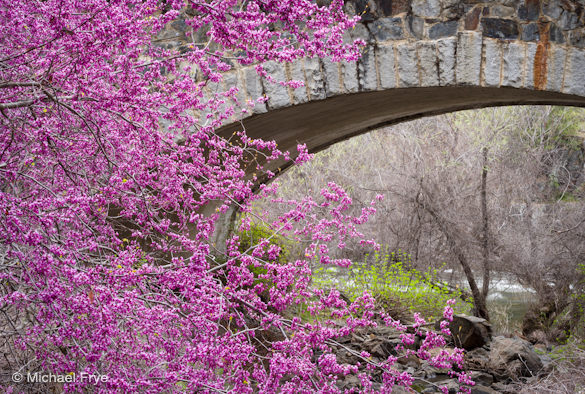It’s turning out to be a great year for poppies in the Merced River Canyon, along Highway 140 just west of Yosemite. While nothing may ever match the spectacular poppy bloom of 2009, this season is coming pretty close. There’s a brilliant display on the north side of the canyon about three miles east of Briceburg, with poppies reaching from the river to the ridge tops. A mile or two further east, around Grandy’s Hill, you can find some great patches of flowers above the road on the south side of the canyon. And there are plenty of poppies at the beginning of the Hite’s Cove trail.
The bloom seems to be spreading from west to east, as it did in 2009. During the last week poppies have appeared in many places on the north side of the canyon from the rock-slide to El Portal, including some of the areas burned in last year’s Motor Fire. I’m hoping that this spread will continue, and we’ll see poppies blooming for two or three more weeks.
Despite the fact that this is mostly unfenced public land, and some of the best poppy displays are on the same side of the river as the highway, access to the flowers is difficult. The hillsides are extremely steep. Not fall-off-and-you’ll die steep (at least in most places), but it requires a lot of agility, stamina, and sure-footedness to climb up many of these hills, and a slip could cause injury. Most people are going to be limited to telephoto views from the road. The one spot with relatively easy access to close-up views of poppies is the beginning of the Hite’s Cove trail.
While I usually prefer soft light (shade or overcast) for flowers, poppies present a dilemma. They only open in full sunlight, so they look much more vibrant during the middle of a sunny day, when the light is harsh. So when photographing poppies you have to balance all the usual considerations about light with the need to have the flowers open.
One of the solutions is to photograph a patch of poppies just after the sun leaves them in the afternoon. I made the image above after climbing one of those typically steep canyon hillsides. The sun had just sunk behind a ridge, so most of the foreground flowers were still open, creating an ideal combination of open poppies and soft light.
Backlight can also work, with the sun shining though all those translucent orange petals from behind. Low-angle direct frontlight can also complement poppies, as it creates few shadows, emphasizing colors and color contrasts.
Meanwhile, along the river banks and creeks in this same canyon, the redbud are peaking. A few have started to leaf out, but most are in prime condition, and should be in good shape for at least another week. And the redbud are a lot easier to get close to than the poppies!
It’s unusual to see the redbud and poppies peaking together. Early April is a pretty typical time to see the redbud, but poppies usually bloom in March. We’re lucky to have such great displays of both flowers at the same time.
Just to make things interesting, of course, two storms are headed this way. The first is expected to move through tonight and tomorrow, and while the second is due to arrive Thursday night. It sounds like Yosemite Valley could get a couple inches of rain out of these two systems, and two or more feet or snow could fall in the high country. The second storm is expected to be colder, and snow could get down to Yosemite Valley by time it’s over.
It’s hard to predict what this weather will do to the poppies. In areas where they’ve already peaked they might fade quickly. But in other spots, where the poppies are just getting started, the additional moisture may actually help sustain the bloom. At least I hope so! And the new snow in the high country will certainly help keep Yosemite’s waterfalls flowing longer.
— Michael Frye
Related Posts: More Poppies; Spring Storm
Michael Frye is a professional photographer specializing in landscapes and nature. He is the author and photographer of The Photographer’s Guide to Yosemite, Yosemite Meditations, and Digital Landscape Photography: In the Footsteps of Ansel Adams and the Great Masters, plus the eBooks Light & Land: Landscapes in the Digital Darkroom, and Exposure for Outdoor Photography. He has written numerous magazine articles on the art and technique of photography, and his images have been published in over thirty countries around the world. Michael has lived either in or near Yosemite National Park since 1983, currently residing just outside the park in Mariposa, California.











This is an amazing picture!! Thanks for posting!
Thank you Eileen!
Wow! How beautiful! I am very envious, we are so dry on the east side, I don’t think we will see much in the way of flowers. I was in Death Valley last week and temps already in the 90’s, but not much blooming.
Kim, thanks! It is a bit strange that we’re having such a good flower year here in the middle of a drought. Something worked for the flowers.
Superb poppy shot. The angle adds to it. The second shot is beautifully composed too.
Thanks Andrew!
Lovely Michael!
Thanks Mary – are thinking of heading this way? 🙂
Beautiful shots Michael, you are a Master! Heading out there this weekend, hope the current rain doesn’t foul things up for me.
Thank you Vincent. I think the flowers should still be good, but if not you can always go to Yosemite. I know, that’s a pretty poor substitute, but you have to take what you can get. 🙂
Hahaha, I guess I will take that consolation prize 🙂 Thanks so much for the updates Michael, it’s awesome of you to post them. Very big help@
Looking at the weather this morning, it seems the rain and wind may persist through to late Friday night. Thinking I may not go until Saturday now instead of Friday. It’s about a 4 hour drive for me, so I want to be sure i time it just right.
Tough to say this early. It’s possible that there may be a break in the storm tomorrow afternoon, so you might want to keep an eye on radar and satellite images. The forecast has changed to include up to a foot of snow at 4000 feet – big change!
Thanks for the images and the info about shooting poppies.
You’ve welcome Rick!
That’s the most poppies I have seen yet. Thanks . Nice pictures
Yes, there are a lot of poppies – thanks!
Great shot of the poppies
Thank you Nancy!
p.s. I LOVE LOVE that red lantern and have been trinyg to convince TJ that we need one in our house for decoration I even tried to tell him how handy it would come in case of a power outage! lol
Beautiful picture of poppies!
Thanks Vasu!
Beautiful shots! Thanks for sharing Michael.
Thank you Maria!
Beautiful photos Michael!
Do you think that there still might be some Redbud trees in bloom in mid-May?
Please send some of that precip to N FL.
We are in our wildfire season right now, with no rain forecasted. ;(
Paolo
Jacksonville, FL
Thanks Paolo. Sorry, there won’t be any redbud blooming in May – they will be done within two weeks. But you might still find some dogwoods blooming in Yosemite Valley then. Wish I could send you some rain, but we don’t have any to spare!
Hi Michael,
Thanks for the reminder about the Dogwoods.
I love photographing the Dogwoods that grow along the rapids on the Mirror Lake Trail.
Really enjoy take my time on that trail to work on photo and video composition.
We had another “Red Flag” day in Jacksonville today with all the smoke from the wildfires.
The smoke was so thick this morning it looked like LA on a bad day.
Amazing and beautiful shot of the poppies Michael. I’m wondering how high you climbed to get this one and just how dangerous it was getting there.
Thank you Terry. It’s hard to say how high I climbed – not that far as the crow flies, but it was steep. I got a good workout, which is one of the side benefits of photography in the Merced River Canyon. 🙂 For me it wasn’t dangerous; I wouldn’t have gone up there if I thought it was a risk. But I’m an reformed mountaineer, and half mountain goat, half photographer.
Hey Michael, I went up Grandy’s hill a weekend earlier but I like your shot better! Nice soft light. Great feel. That hill makes me want a lighter tripod!
Hey, it’s nice to hear from the famous man himself! You must be famous because you have a whole hill named after you. 🙂 Well anyway you made that hill famous in my eyes because of the great photo you made of it many years ago.
I think the bloom has improved on your hill in a week, or at least in the patches just west of it. Yes, that hill makes me want a lighter tripod, camera, and self! It’s awfully steep.
Brilliant photos. I am going to be in Yosemite in Early June. Will there still be any wildflowers?
Thanks John. There are likely to be wildflowers in the meadows in Yosemite Valley in early June – cow parsnip, irises, perhaps azaleas – though this is not a typical year, and it’s hard to say what might happen.
I absolutely love these pictures! The redbud is my favorite though. The texture of the bridge really makes it pop!
Beautiful shots Michael. I was there at the Merced River in 2009! What a year.
Could you give me directions where State Creek Bridge is, the place you got the beautiful Red Bud picture. Would be very much appreciated.
Farrel Brizendine
Hi Michael
Spectacular shot! I want to visit there but can you offer some directions on how to reach this area? I drove up Incline Road for the first time a month ago but there was nothing blooming…
Wheres Slate creek bridge & Grandy’s hill? I am sure its not far from where I was. Is it hard to hike up there?
BTW still learning your nice method in your new Lightroom 5 book. Very useful info indeed!
Thanks Andy! I’m not sure I can describe these spots any better than I did in my latest post. Slate Creek Bridge is about three miles east of Briceburg. Grandy’s Hill is another couple of miles east of that, or about two miles west of the Furguson Rock slide detour. All the hillsides where the poppies grow are difficult and dangerous to hike up on; you should only attempt it if you’re agile, sure-footed, have an excellent sense of balance, and are willing to risk injury. I don’t give specific directions to many of the places I’ve made photographs in the canyon because I don’t want to be responsible for someone getting hurt.